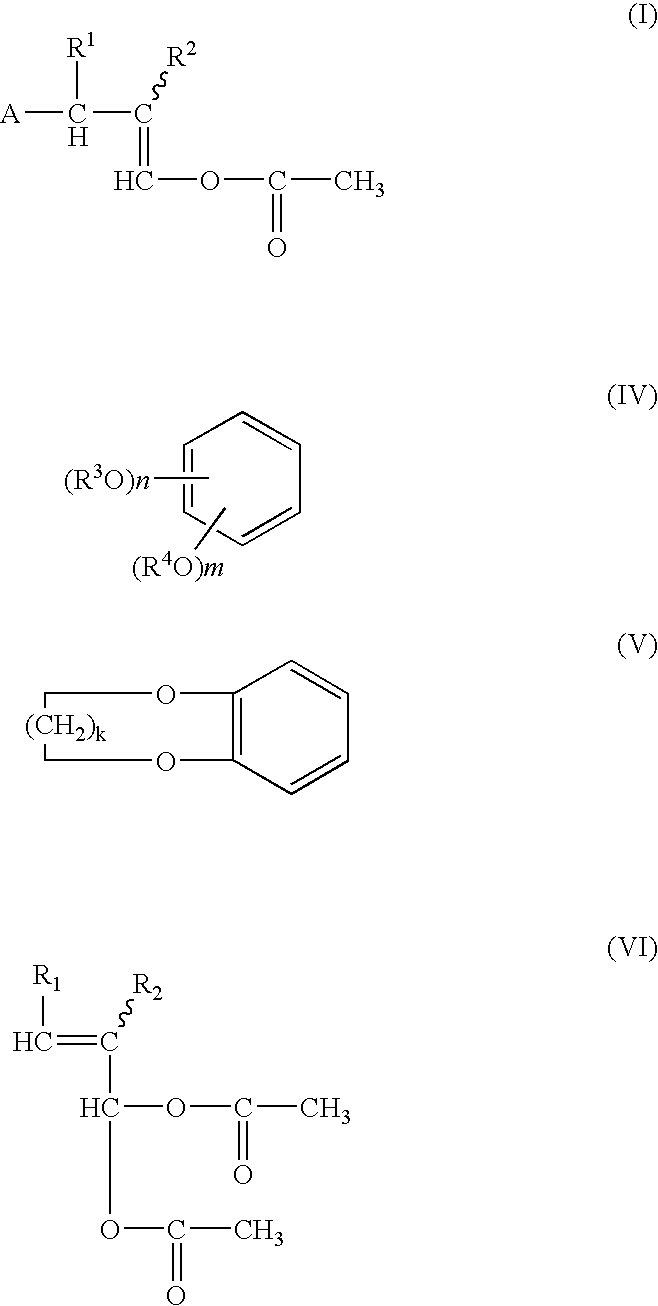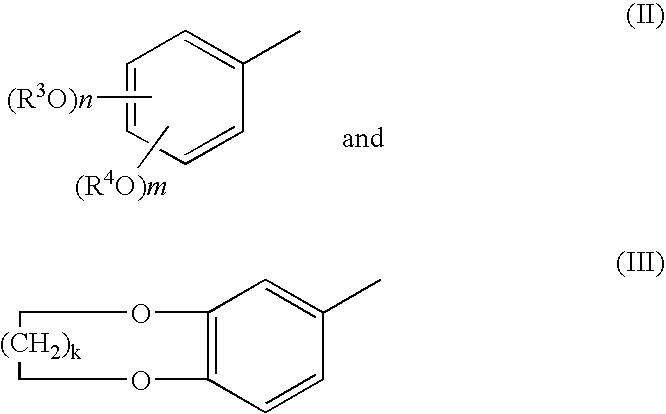Process for producing 1-acetoxy-3-(substituded phenyl) propenes
a technology of phenyl propene and acetoxy-3, which is applied in the preparation of carboxylic acid esters, chemistry apparatus and processes, and organic chemistry. it can solve the problems of low yield of target compound, complex and meticulous care, and unsatisfactory results of the process. achieve the effect of easy process and high efficiency
- Summary
- Abstract
- Description
- Claims
- Application Information
AI Technical Summary
Benefits of technology
Problems solved by technology
Method used
Image
Examples
example 1
[0060] In an argon gas atmosphere at a temperature of 20° C., a 20 ml flask was charged with a mixed solution of 6.83 g (56.0 m moles) of 1,2-methylenedioxybenzene and a solution 1.05 g (5.6 m moles) of 3,3-diacetoxy-2-methylpropene in a purity degree of 91.8% by mass, and the mixed solution was mixed with 74 mg (0.52 m mole) of boron trifluoride-diethylether complex. The resultant mixture was stirred at a temperature of 23° C. for one hour to provide a reaction liquid. The reaction liquid was mixed with 50 ml of ethyl acetate, and a resultant organic phase layer formed in the reaction liquid is separated and collected, washed three times with water in an amount of 50 ml, and dried with anhydrous sodium sulfate to remove the solvent. The resultant residue was refined by a column chromatography on silica gel using a solvent ethyl acetate / n-hexane mixture in a mixing ratio by volume of 1 / 13, the target 1-acetoxy-2-methyl-3-(3,4-methylenedioxyphenyl)propene was eluted and collected in ...
example 2
[0065] In an argon gas atmosphere at a temperature of 20° C., a 20 ml flask was charged with a mixed solution of 6.83 g (55.97 m moles) of 1,2-methylenedioxybenzen and 0.96 g (4.88 m moles) of 3,3-diacetoxy-2-methylpropene in a purity degree of 88.0% by mass, and the mixed solution was mixed with 77 mg (0.54 m mole) of boron trifluoride-diethylether complex. The resultant mixture was stirred at a temperature of 23° C. for one hour to provide a reaction liquid. The reaction liquid was mixed with 100 ml of acetonitrile.
[0066] The resultant reaction liquid was subjected to a high performance liquid chromatographic analysis in accordance with an absolute calibration curve method. In the result of the analysis, the yield of 1-acetoxy-2-methyl-3-(3,4-methylenedioxyphenyl)propene was 97.1%. Also, the reaction liquid contained non-reacted 1,2-methylenedioxybenzene in an amount of 5.86 g.
examples 3 to 6
[0067] In each of Examples 3 to 6, the same reaction and analysis as in Example 2 were carried out, except that a 1,2-methylenedioxybenzene, 3,3-diacetoxy-2-methylpropene and boron trifluroride-ether complex were employed in the amounts as shown in Table 1 and the reaction temperature and the reaction time were changed as shown in Table 1.
[0068] The reaction results are shown in Table 1.
TABLE 1ReactionReactionYield ofCompound 1Compound 2BF3.Et2Otemperaturetimecompound 3(mmol)(*)1(mmol)(*)2(mmol)(*)4(° C.)(h)(%)(*)3Example327.995.550.540284.6427.945.550.5623189.3527.945.550.2723386.8655.955.615.58230.593.8
Note:
(*)1Compound 1: 1,2-methylenedioxybezen
(*)2Compound 2: 3,3-diacetoxy-2-methylpropene
(*)3Compound 3: 1-acetoxy-2-methyl-3-(3,4-methylenedioxyphenyl) propene
(*)4BF3.Et2O: Boron triflate-diethylethel complex
PUM
| Property | Measurement | Unit |
|---|---|---|
| atomic numbers | aaaaa | aaaaa |
| atomic numbers | aaaaa | aaaaa |
| time | aaaaa | aaaaa |
Abstract
Description
Claims
Application Information
 Login to View More
Login to View More - R&D
- Intellectual Property
- Life Sciences
- Materials
- Tech Scout
- Unparalleled Data Quality
- Higher Quality Content
- 60% Fewer Hallucinations
Browse by: Latest US Patents, China's latest patents, Technical Efficacy Thesaurus, Application Domain, Technology Topic, Popular Technical Reports.
© 2025 PatSnap. All rights reserved.Legal|Privacy policy|Modern Slavery Act Transparency Statement|Sitemap|About US| Contact US: help@patsnap.com



